Caterpillars are the larval stage of butterflies and moths, and they come in an incredible variety of colors, shapes, and sizes. Some are harmless plant feeders, while others are equipped with stinging hairs or bright warning colors to protect themselves from predators. From the famous Monarch to the fearsome-looking Hickory Horned Devil, each species has unique features, host plants, and survival tactics.
In this guide, you’ll explore 25 fascinating types of caterpillars, each with its own story in nature.
1. Monarch Caterpillar
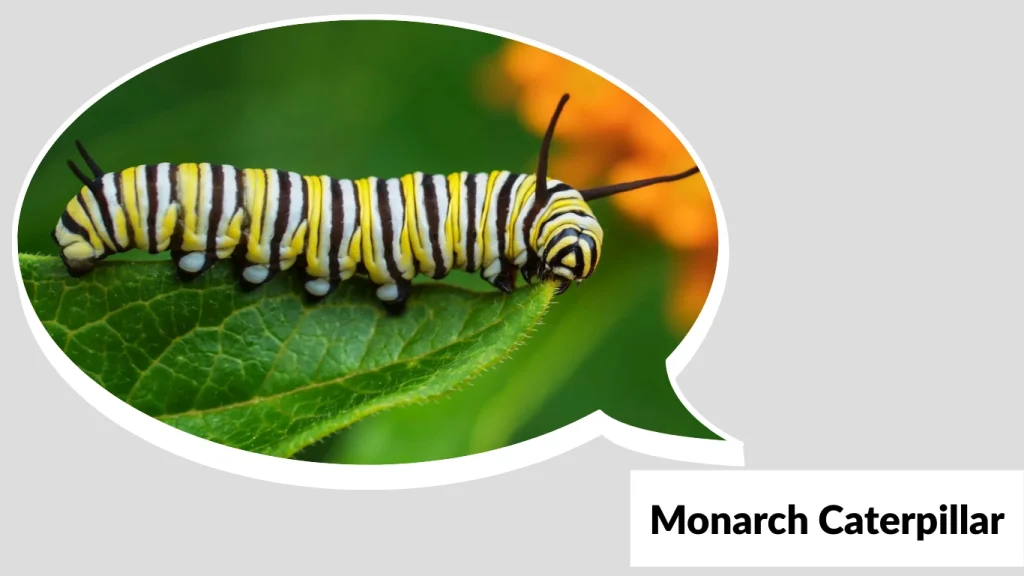
The Monarch caterpillar (Danaus plexippus) is one of the most recognized caterpillars in the world. Known for its striking stripes of black, white, and yellow, it eventually transforms into the iconic Monarch butterfly. This species is also famous for its dependence on milkweed plants, which serve as its only food source during the larval stage.
Identification
- Body marked with black, white, and yellow stripes
- Two pairs of black tentacle-like filaments (front and rear)
- Smooth body without spines or hair
- Grows up to about 2 inches long
Habitat and Host Plant
Monarch caterpillars are commonly found in fields, gardens, and meadows where milkweed grows. The plant is essential not only for their diet but also for their survival, as it provides toxins that make both the caterpillar and butterfly unpalatable to predators.
Life Cycle
They pass through five instar stages, shedding their skin as they grow. After reaching full size, the caterpillar forms a jade-green chrysalis adorned with golden spots before emerging as a butterfly.
Behavior and Defense
Monarch caterpillars feed voraciously on milkweed leaves. The toxins they ingest act as a defense mechanism, protecting them from birds and other predators.
2. Black Swallowtail Caterpillar
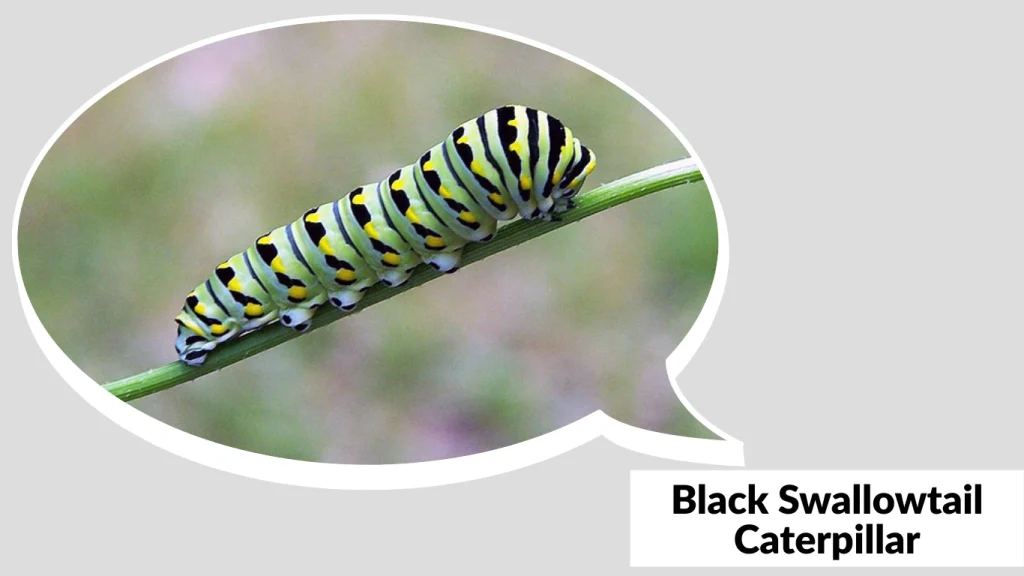
The Black Swallowtail caterpillar (Papilio polyxenes) is a vibrant species that transforms into a beautiful black and yellow swallowtail butterfly. It is often mistaken for the Monarch due to its striped appearance but can be identified by its unique green body with black bands and yellow spots.
Identification
- Bright green body with black bands and yellow spots
- Smooth body without hairs or spines
- Can emit a yellow, forked organ (osmeterium) when threatened
- Grows up to about 1.5–2 inches long
Habitat and Host Plant
This caterpillar thrives in gardens, fields, and open spaces, particularly where parsley, dill, fennel, and carrot plants are available. These plants are their primary host species.
Life Cycle
It goes through five instars, changing from a spiky black caterpillar with white spots in early stages to the smooth green-striped form in later instars.
Behavior and Defense
When disturbed, it displays its osmeterium, releasing a foul smell to deter predators.
3. Eastern Tiger Swallowtail Caterpillar

The Eastern Tiger Swallowtail caterpillar (Papilio glaucus) is notable for its dramatic transformation in appearance through its growth stages. It eventually becomes a striking yellow-and-black butterfly found across North America.
Identification
- Early instars resemble bird droppings (brown and white)
- Later instars are bright green with large eyespots on the thorax
- Smooth body with no spines
- Can reach up to 2 inches in length
Habitat and Host Plant
Commonly found in woodlands, gardens, and near rivers where host trees like tulip trees, wild cherry, ash, and willow are abundant.
Life Cycle
The caterpillar molts through several instars, shifting from camouflaged bird-dropping mimicry to a green form with false eyes that startle predators.
Behavior and Defense
Uses eyespots to intimidate birds and has an osmeterium that releases a strong odor when threatened.
4. Spicebush Swallowtail Caterpillar
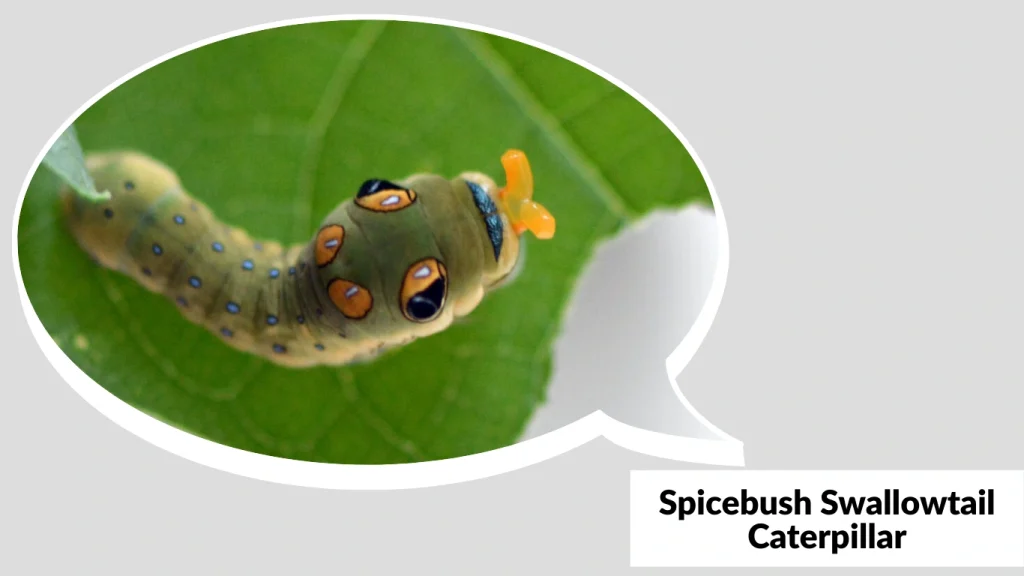
The Spicebush Swallowtail caterpillar (Papilio troilus) is a fascinating species that uses mimicry as a survival tactic. It is well-known for its large, false eye spots that give it the appearance of a small snake to scare predators.
Identification
- Early stages are brown and white, resembling bird droppings
- Later stages are bright green with large yellow-and-black false eyespots
- Smooth body with no spines or hairs
- Can grow up to 2 inches long
Habitat and Host Plant
This caterpillar is mainly found in forests, woodlands, and gardens where spicebush and sassafras plants grow. These plants serve as the primary host food.
Life Cycle
After passing through multiple instars, the caterpillar creates a folded leaf shelter, curling the leaf around itself for protection. It later pupates inside a brown chrysalis that resembles a dried leaf.
Behavior and Defense
Spicebush caterpillars use mimicry and camouflage at different stages. Their bird-dropping disguise in early instars and snake-like eyespots in later instars effectively deter birds and other predators.
5. Pipevine Swallowtail Caterpillar

The Pipevine Swallowtail caterpillar (Battus philenor) is a striking species with bold coloration that signals its toxicity. Feeding exclusively on pipevine plants, it absorbs toxins that make it unpalatable to predators.
Identification
- Dark reddish-brown to black body with rows of orange or red fleshy tubercles
- Several spiny, soft projections along the body
- Grows up to 2 inches long
- Smooth yet spiky appearance due to soft tubercles
Habitat and Host Plant
It inhabits woodlands, fields, and gardens where pipevine plants are found. These plants provide not only nutrition but also chemical protection.
Life Cycle
The caterpillar passes through five instar stages, becoming more vividly colored in later stages. It eventually forms a brown or green chrysalis that blends with its surroundings before emerging as a butterfly.
Behavior and Defense
The toxins from the pipevine plant make the caterpillar and butterfly highly poisonous to predators. Bright coloration serves as a warning signal, while its osmeterium adds an additional line of chemical defense.
6. Luna Moth Caterpillar
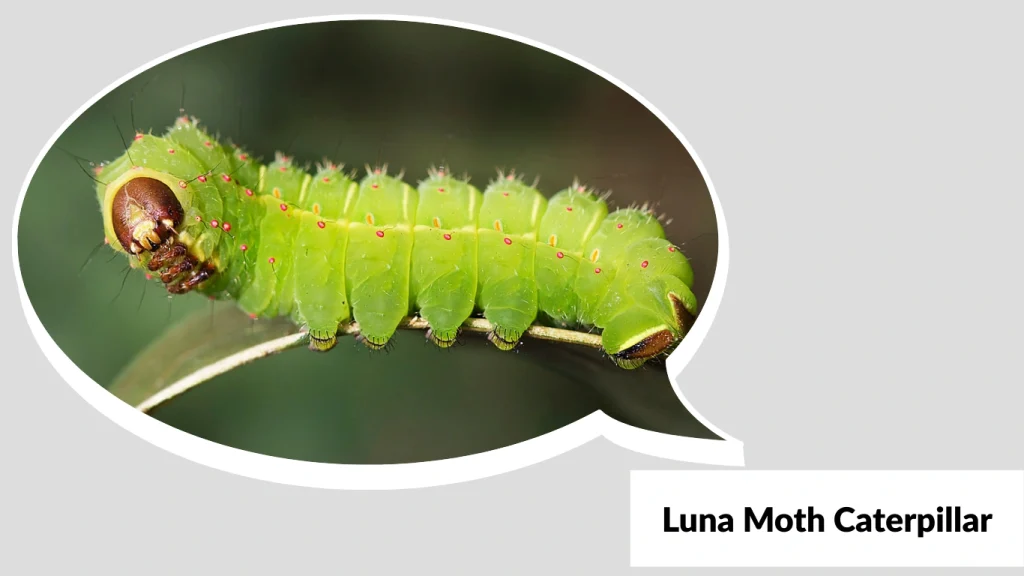
The Luna Moth caterpillar (Actias luna) is the larval stage of one of North America’s most enchanting moths. Its bright green body and bristled segments make it easy to recognize.
Identification
- Bright green body with yellow lines running along the sides
- Red or orange tubercles on each segment
- Covered with fine, short hairs
- Can grow up to 3 inches long
Habitat and Host Plant
Found in deciduous forests, the caterpillar feeds on a variety of trees including hickory, walnut, persimmon, and sweetgum.
Life Cycle
It passes through five instar stages, becoming larger and brighter with each molt. At maturity, it spins a silk cocoon among leaves, later emerging as the striking Luna moth.
Behavior and Defense
When threatened, it rears its head and makes clicking noises by rubbing its mandibles, sometimes regurgitating to deter predators.
7. Cecropia Moth Caterpillar

The Cecropia Moth caterpillar (Hyalophora cecropia) is one of the largest caterpillars in North America and develops into the impressive Cecropia moth. Its size and colorful tubercles make it one of the most unique larval forms.
Identification
- Bright green to bluish body with rows of large, colorful tubercles (yellow, blue, and red)
- Covered in tiny black bristles on each tubercle
- Reaches up to 4–5 inches in length
- Plump, segmented body
Habitat and Host Plant
Found in woodlands and suburban areas, it feeds on a wide range of trees including maple, birch, cherry, apple, and willow.
Life Cycle
This caterpillar undergoes five instars, becoming larger and more vividly colored at each stage. It spins a dense, brown silk cocoon attached to branches where it pupates and later emerges as a moth.
Behavior and Defense
Despite its intimidating size and appearance, the caterpillar is harmless. Its bright tubercles may act as a deterrent to predators, signaling potential danger even though it is non-toxic.
8. Polyphemus Moth Caterpillar

The Polyphemus Moth caterpillar (Antheraea polyphemus) is another giant silk moth species, notable for its bright green body and sheer size. It transforms into the large Polyphemus moth, which is recognized by its striking eyespots.
Identification
- Bright green body with diagonal yellow lines on each segment
- Small reddish-orange tubercles with fine bristles
- Can grow up to 3–4 inches long
- Plump and cylindrical shape
Habitat and Host Plant
This caterpillar is highly adaptable and feeds on many trees such as oak, maple, birch, willow, apple, and hickory. It is found throughout North America in forests and suburban landscapes.
Life Cycle
It undergoes several molts, gradually developing stronger markings. At maturity, it spins a tough, oval-shaped silk cocoon usually attached to tree branches or leaf litter.
Behavior and Defense
Its green coloration helps it camouflage among leaves. When disturbed, it may thrash its body or regurgitate leaf material as a deterrent.
9. Io Moth Caterpillar
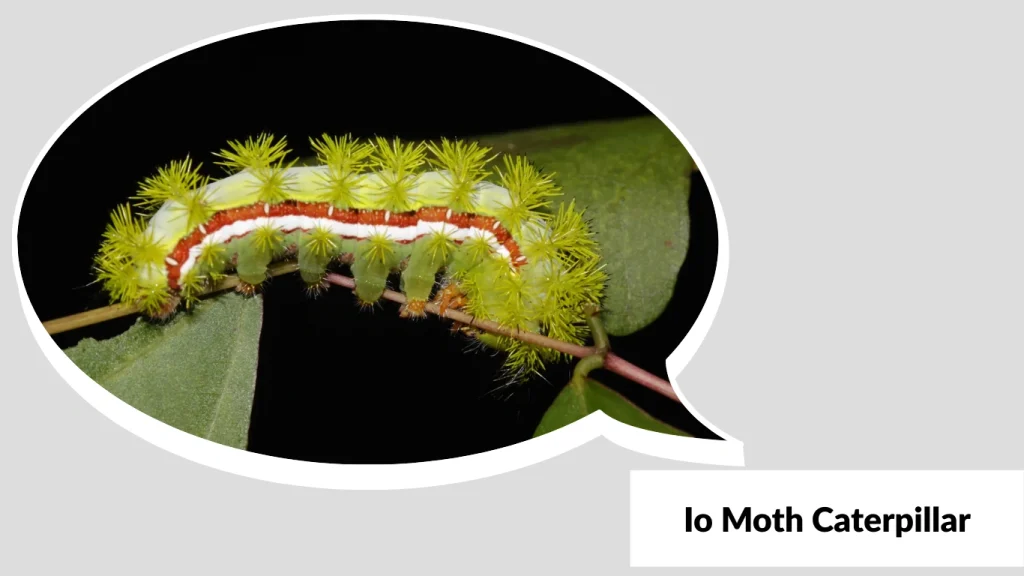
The Io Moth caterpillar (Automeris io) is well-known for its stinging spines, which can deliver a painful reaction. Despite its bright green beauty, it is best admired from a distance.
Identification
- Bright green body with red and white stripes along the sides
- Covered in branched stinging spines that release venom on contact
- Reaches 2–3 inches in length
- Cylindrical body with slightly tapered ends
Habitat and Host Plant
Io moth caterpillars are found in gardens, fields, and forests, feeding on a wide range of host plants including willow, hackberry, mesquite, and various grasses.
Life Cycle
After several instar stages, the caterpillar pupates in a loose cocoon of leaves and silk. It later emerges as the Io moth, which has bold eyespots on its hindwings to scare predators.
Behavior and Defense
The spines provide strong protection, as even light contact can cause irritation, burning, and redness in human skin. Their bright coloration also serves as a warning signal to predators.
10. Hickory Horned Devil

The Hickory Horned Devil (Citheronia regalis) is the largest caterpillar in North America and grows into the regal moth, also called the royal walnut moth. Despite its fierce appearance, it is harmless to humans.
Identification
- Bright green to turquoise body in later stages
- Long, curved, orange-red spines with black tips on the thorax
- Body covered with smaller black-tipped spines
- Can grow up to 5–6 inches long
Habitat and Host Plant
This giant caterpillar feeds on a variety of trees including hickory, walnut, persimmon, sumac, and sweetgum. It is found in forests and wooded areas of the eastern United States.
Life Cycle
The caterpillar molts through several stages, becoming more fearsome with each instar. Once mature, it burrows into soil to pupate and later emerges as the impressive regal moth.
Behavior and Defense
Its size, horns, and spines give it an intimidating appearance that deters predators, though it does not sting or bite.
11. White-Marked Tussock Caterpillar
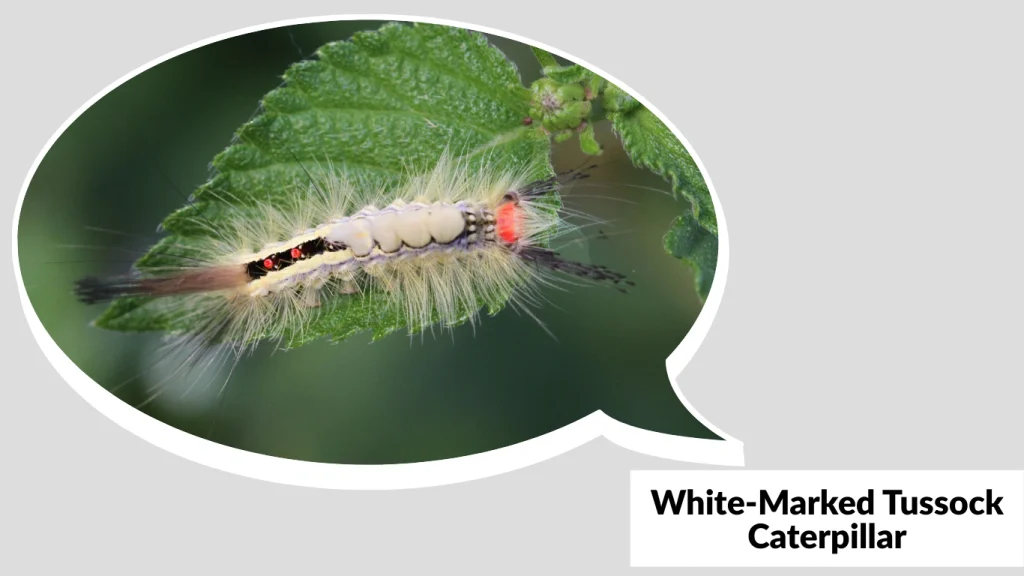
The White-Marked Tussock caterpillar (Orgyia leucostigma) is a brightly colored and hairy species often seen feeding in groups. It later develops into a rather plain moth, but the caterpillar stage is striking.
Identification
- Black body with yellow stripes running lengthwise
- Four white toothbrush-like tufts of hair on the back
- Red head with long black hair pencils at both ends
- Grows up to about 1.5 inches long
Habitat and Host Plant
This caterpillar feeds on a wide range of deciduous trees such as oak, elm, birch, apple, and willow. It is common in woodlands and suburban areas.
Life Cycle
The caterpillar passes through several instars with increasingly prominent tufts of hair. After maturity, it spins a grayish-white cocoon, often incorporating its own hairs, before emerging as a moth.
Behavior and Defense
The hairs can cause skin irritation in sensitive individuals. Their bright coloration and tufts serve as warning signals to predators.
12. Gypsy Moth Caterpillar

The Gypsy Moth caterpillar (Lymantria dispar) is an invasive species that has caused significant defoliation of trees in North America. Its hairy body and distinct row patterns make it easy to identify.
Identification
- Dark, hairy body covered with long bristles
- Five pairs of blue spots followed by six pairs of red spots along the back
- Can grow up to 2 inches long
- Caterpillar has a rough, bristly appearance
Habitat and Host Plant
Feeds on over 500 species of trees and shrubs, but especially favors oak, birch, and aspen. It thrives in forests, woodlands, and suburban areas.
Life Cycle
After passing through several instars, it pupates in a brown cocoon attached to bark or other surfaces. Adults emerge as moths, with females flightless and males capable of flying.
Behavior and Defense
The caterpillar is highly destructive, often feeding in large numbers and stripping trees of leaves. Hairs may cause mild irritation in some people.
13. Tent Caterpillar

Tent Caterpillars (Malacosoma species) are known for building large silk tents in trees, where they gather and feed communally. These caterpillars often appear in spring and can cause noticeable defoliation.
Identification
- Generally black or dark brown body with a white stripe down the back
- Covered in short hairs with blue and yellow markings on sides
- Grow up to 2 inches long
- Often seen in clusters inside silk tents on trees
Habitat and Host Plant
They prefer deciduous trees such as cherry, apple, and oak. They build tents in branch forks, especially in orchards and woodland edges.
Life Cycle
The caterpillars emerge in early spring, constructing silk tents for shelter. After several weeks of feeding and molting, they pupate in silk cocoons before emerging as adult moths.
Behavior and Defense
Tent caterpillars are social feeders, returning to their silk nests between feeding. Large populations can defoliate trees, but most trees recover.
14. Fall Webworm Caterpillar
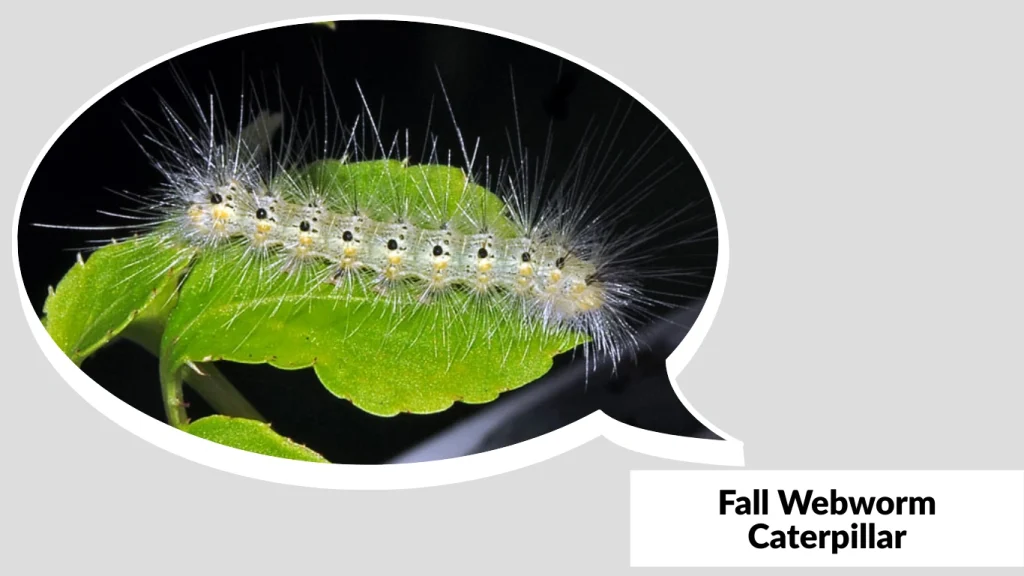
The Fall Webworm (Hyphantria cunea) is a widespread species known for creating large silken webs that cover tree branches. Unlike tent caterpillars, they enclose leaves within their webs while feeding.
Identification
- Body is pale yellow to greenish with black spots
- Covered in long white hairs from scattered tubercles
- Grows up to 1–1.5 inches long
- Often found in large groups inside webbed branches
Habitat and Host Plant
Feeds on over 100 hardwood trees, including walnut, hickory, pecan, and fruit trees. Commonly found in orchards, forests, and suburban landscapes.
Life Cycle
Larvae hatch in late summer, spinning webs that expand as they feed. After multiple instars, they pupate in soil or leaf litter and overwinter in the pupal stage before emerging as moths.
Behavior and Defense
Their communal webs provide protection from predators and weather. Long hairs can deter birds and small animals.
15. Cabbage White Caterpillar
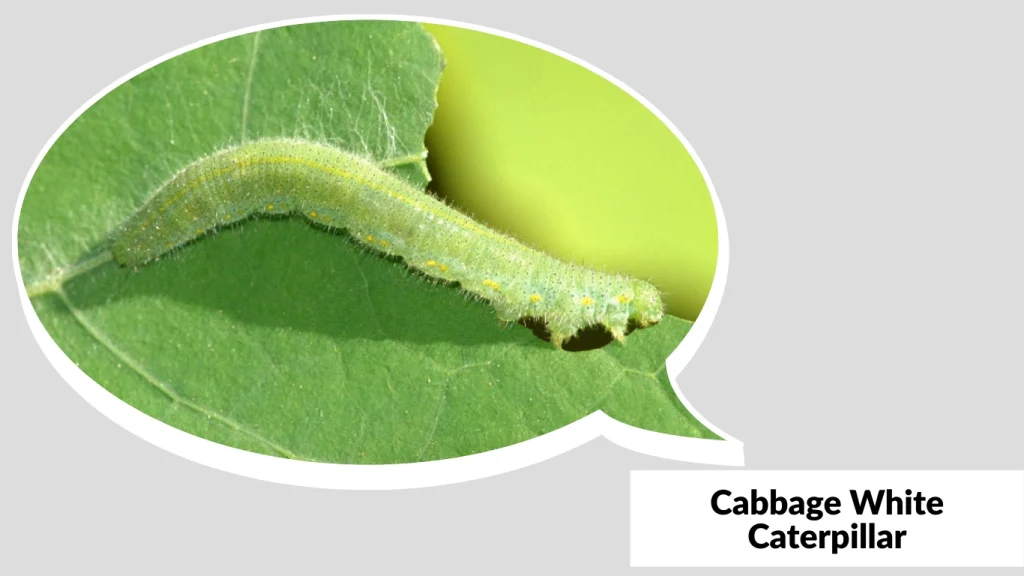
The Cabbage White caterpillar (Pieris rapae) is the larval stage of one of the most common garden butterflies. It is considered a pest due to its feeding on cruciferous crops.
Identification
- Velvety green body with faint yellow stripes along the back and sides
- Small, fine hairs covering the body
- Reaches up to 1–1.25 inches long
- Blends well with cabbage leaves
Habitat and Host Plant
Found mainly in gardens and agricultural fields, feeding on cabbage, broccoli, kale, mustard, and other Brassica plants.
Life Cycle
After hatching from small yellow eggs, the caterpillars feed heavily on host plants. They later pupate as a greenish-brown chrysalis attached to stems or leaves before becoming butterflies.
Behavior and Defense
Their green coloration provides camouflage among cabbage leaves. When disturbed, they drop off the plant or curl into a defensive position.
16. Armyworm Caterpillar

The Armyworm (Mythimna unipuncta and related species) is a notorious agricultural pest that feeds in large groups, often causing severe crop damage. Their name comes from their habit of moving in “armies” across fields.
Identification
- Smooth, green to brown body with stripes running lengthwise
- Three narrow yellowish lines on the back
- Grows up to 1.5–2 inches long
- Lacks prominent hairs or spines
Habitat and Host Plant
Found in grasslands, crop fields, and lawns, feeding on corn, rice, wheat, barley, and other cereal grains.
Life Cycle
Eggs hatch in clusters, and larvae feed in groups before spreading out as they mature. After several instars, they pupate in soil before emerging as moths.
Behavior and Defense
Armyworms are aggressive feeders, often stripping plants bare. They rely on camouflage for protection from predators.
17. Cutworm Caterpillar
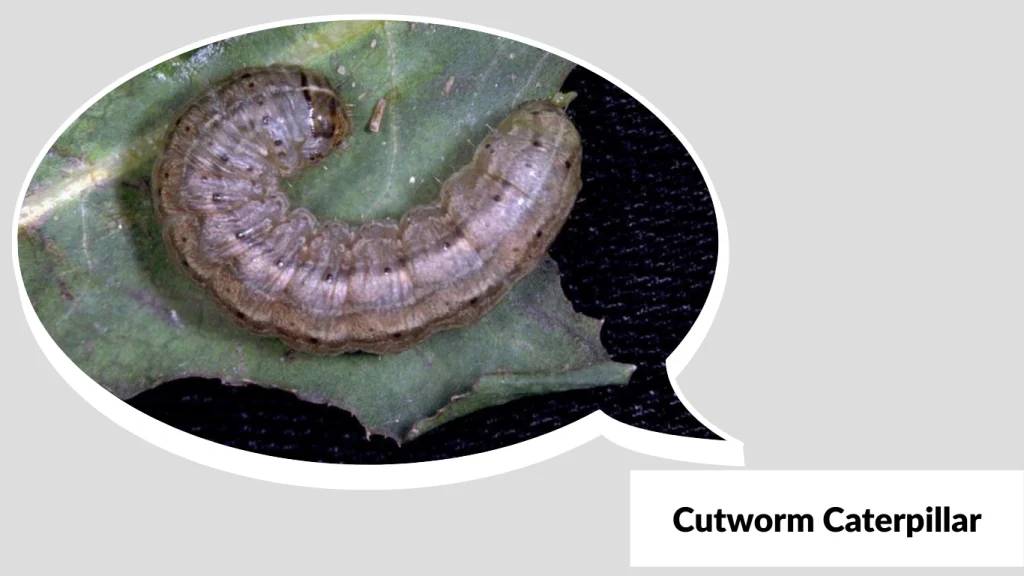
Cutworms (Agrotis species) are common caterpillars that damage seedlings by cutting through stems at ground level. They are usually active at night and hide in soil during the day.
Identification
- Plump, smooth body that is gray, brown, or black
- Segmented and slightly shiny appearance
- Usually curl into a C-shape when disturbed
- Grow up to 1–2 inches long
Habitat and Host Plant
They inhabit gardens and agricultural fields, feeding on young plants such as lettuce, cabbage, corn, and tomato.
Life Cycle
Cutworms emerge in spring from overwintered eggs or larvae. After several weeks of feeding, they pupate in the soil and later emerge as moths.
Behavior and Defense
They are nocturnal feeders, hiding under soil clods or plant debris during the day. Their habit of cutting stems at ground level makes them especially destructive.
18. Tomato Hornworm

The Tomato Hornworm (Manduca quinquemaculata) is a large caterpillar often found in vegetable gardens. It is considered a serious pest of tomato plants and other members of the nightshade family.
Identification
- Bright green body with white V-shaped markings on the sides
- A straight black horn protruding from the rear end
- Smooth body with tiny granules
- Can grow up to 3–4 inches long
Habitat and Host Plant
Feeds primarily on tomato, eggplant, pepper, and potato plants. Found in gardens, farms, and areas where solanaceous plants are grown.
Life Cycle
After hatching, the caterpillar passes through five instars, consuming large amounts of foliage. Once fully grown, it burrows into the soil to pupate, later emerging as a hawk moth.
Behavior and Defense
Camouflages well among tomato leaves. Large size and horn give it an intimidating look, though it is harmless to humans.
19. Tobacco Hornworm
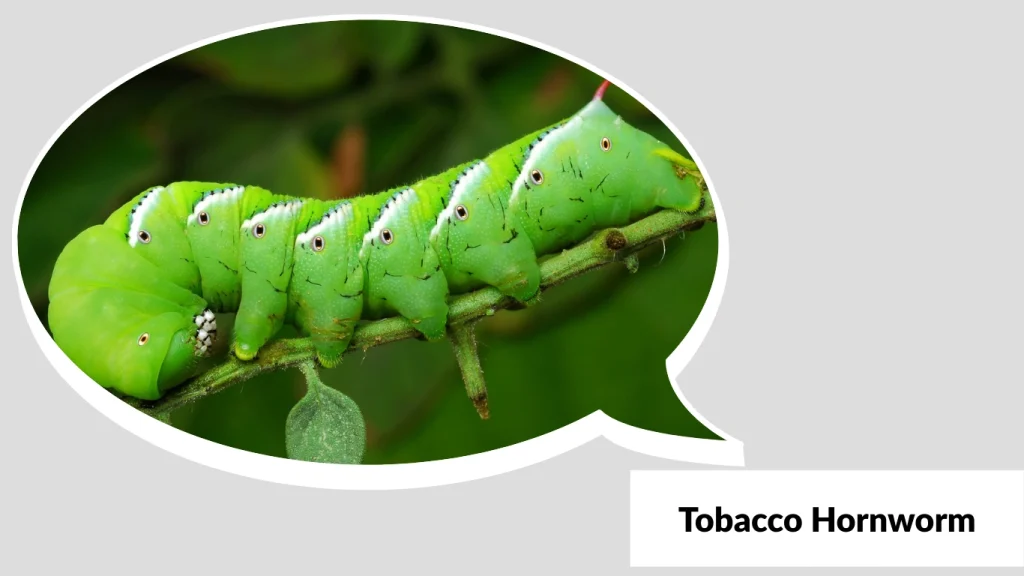
The Tobacco Hornworm (Manduca sexta) is closely related to the tomato hornworm and is also a destructive garden pest. It is often confused with its cousin but has distinctive markings.
Identification
- Green body with diagonal white stripes along the sides
- A red, curved horn at the rear end
- Reaches up to 3–4 inches long
- Smooth body with granulated texture
Habitat and Host Plant
Feeds mainly on tobacco, tomato, pepper, potato, and other nightshade family plants. Found in fields and gardens.
Life Cycle
It undergoes five larval stages, consuming large portions of leaves and fruits. Pupation occurs underground in a sturdy brown case before emerging as a sphinx moth.
Behavior and Defense
Uses camouflage to blend with foliage. Its horn and large size make it appear dangerous, but it does not sting or bite.
20. Woolly Bear Caterpillar
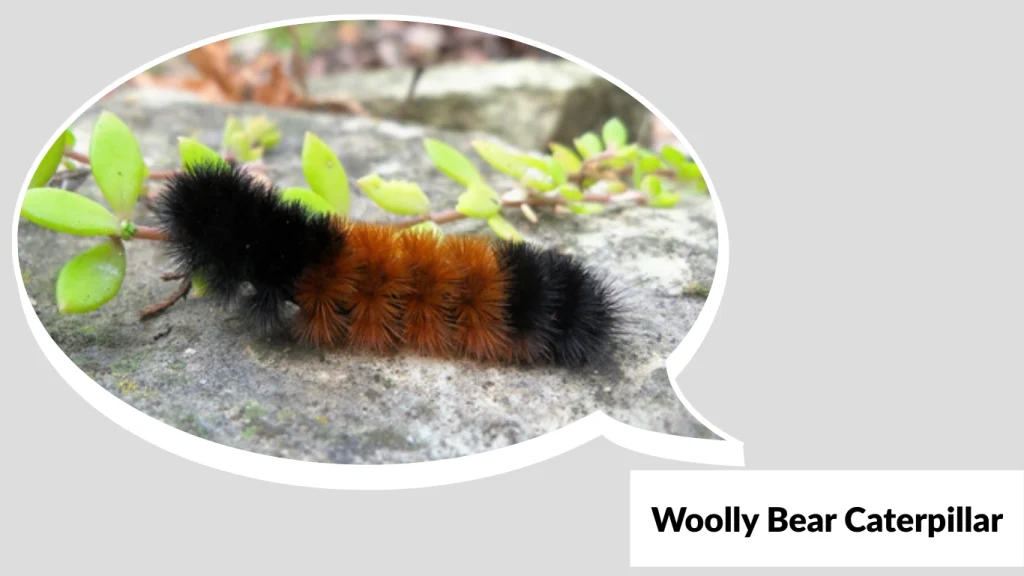
The Woolly Bear caterpillar (Pyrrharctia isabella) is one of the most familiar caterpillars in North America, often seen crossing roads in autumn. It eventually becomes the Isabella tiger moth. Folklore suggests its color bands predict winter severity.
Identification
- Fuzzy body with black hairs at both ends and a rusty-brown band in the middle
- Covered in dense bristles (setae)
- Grows up to 2 inches long
- Cylindrical shape with no horns or spines
Habitat and Host Plant
Feeds on a wide range of low-growing plants, including clover, dandelion, nettles, and grasses. Commonly found in fields, gardens, and along roadsides.
Life Cycle
Overwinters as a caterpillar, surviving freezing temperatures by producing natural antifreeze. In spring, it pupates in a cocoon of its own hairs before becoming a moth.
Behavior and Defense
Rolls into a tight ball when disturbed, using its bristly hairs as a deterrent to predators.
21. Saddleback Caterpillar
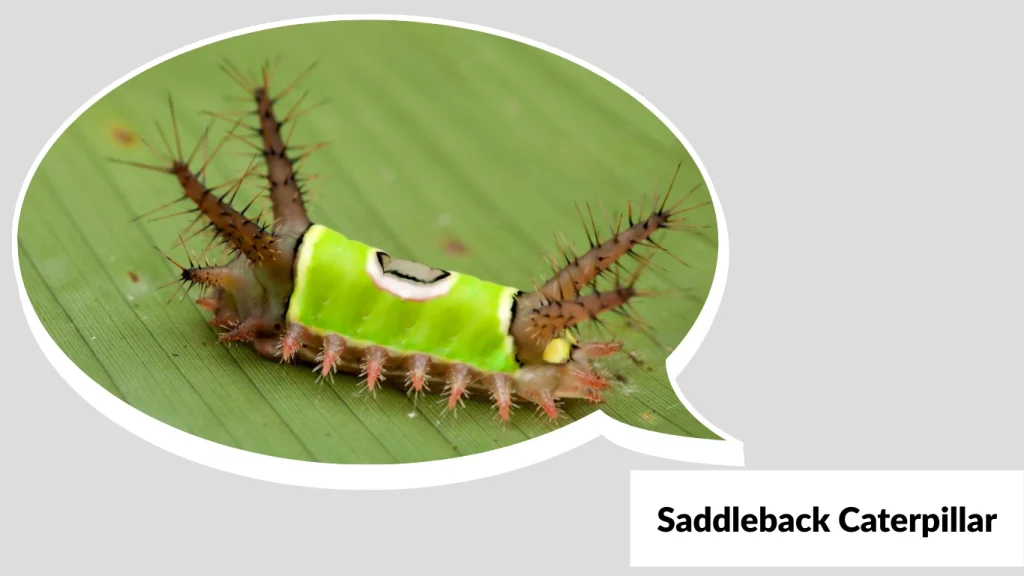
The Saddleback caterpillar (Acharia stimulea) is a small but striking caterpillar recognized for its bold colors and powerful sting. Despite its attractive look, it should be avoided.
Identification
- Bright green body with a brown patch in the middle resembling a saddle
- Two pairs of fleshy horns at front and rear, covered in venomous spines
- Additional stinging spines along the body sides
- Grows up to 1 inch long
Habitat and Host Plant
Feeds on a variety of plants, including corn, oak, apple, elm, and roses. Found in gardens, forests, and agricultural fields.
Life Cycle
Undergoes several instars, each with increasingly vibrant colors and spines. Pupates in a silk cocoon before emerging as a small brown moth.
Behavior and Defense
Defends itself with venomous spines that deliver a painful sting, causing swelling, redness, and burning sensations in humans.
22. Puss Caterpillar
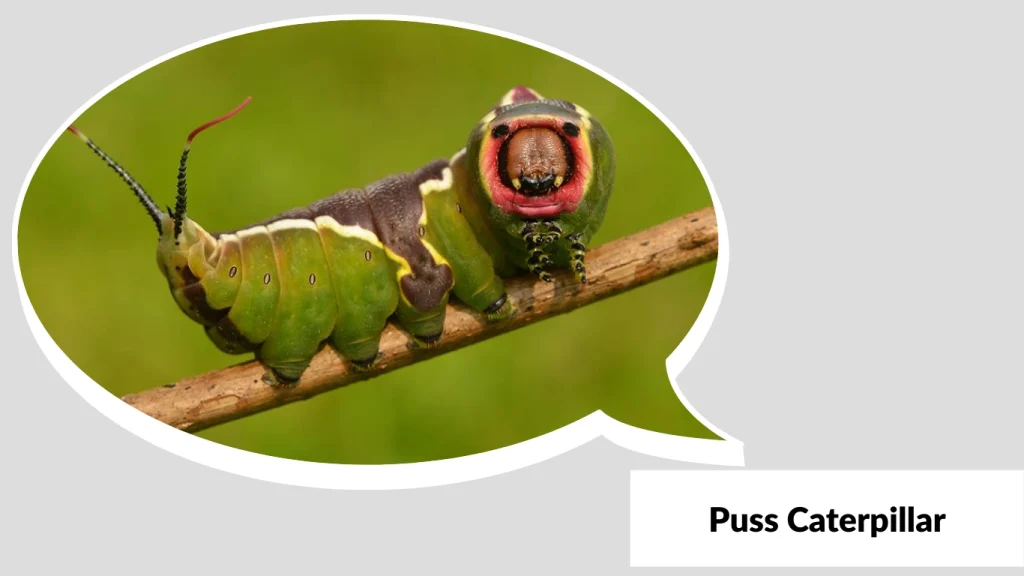
The Puss caterpillar (Megalopyge opercularis) is one of the most venomous caterpillars in North America. Despite its soft, furry appearance, it hides venomous spines beneath its silky hairs.
Identification
- Covered in dense, silky, fur-like hairs that resemble a small tuft of cotton or cat fur
- Colors range from gray to orange-brown
- Small and stout, usually 1–1.5 inches long
- Venomous spines hidden beneath the hairs
Habitat and Host Plant
Feeds on oak, elm, hackberry, and citrus trees. Commonly found in forests, gardens, and landscaped areas in the southern United States.
Life Cycle
Goes through several instar stages, retaining its furry appearance throughout. After maturity, it spins a tough cocoon and emerges as a southern flannel moth.
Behavior and Defense
Highly venomous—its sting causes intense pain, burning, nausea, and swelling. The hairs act as camouflage, making it look harmless but dangerous to touch.
23. Buck Moth Caterpillar
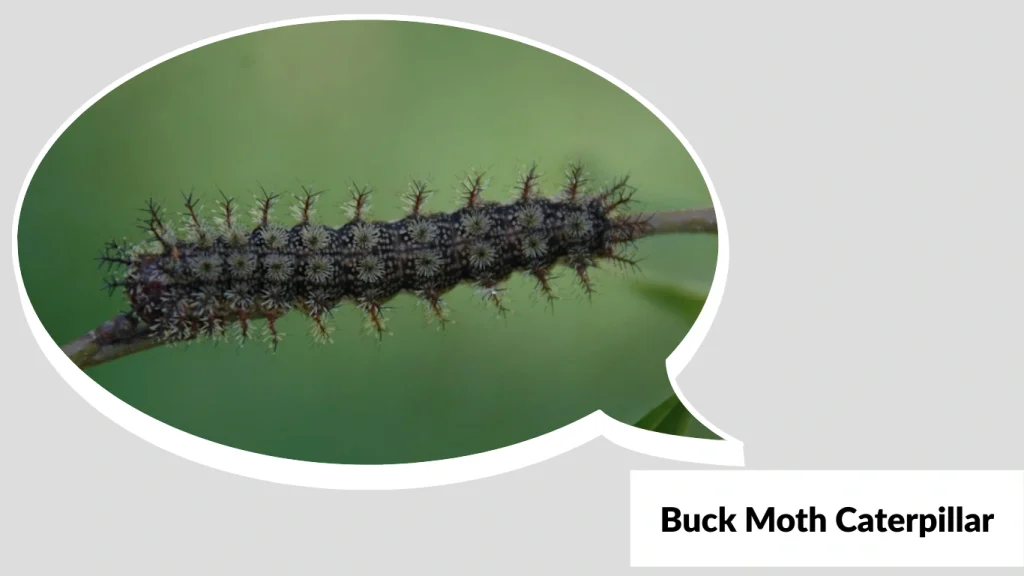
The Buck Moth caterpillar (Hemileuca maia) is a spiny, venomous species found in oak forests. It is well-known for feeding in groups and later developing into the buck moth.
Identification
- Dark brown to black body with rows of branched spines
- Covered in venomous spines that can cause painful stings
- Long and slender, reaching up to 2.5 inches
- White or yellow speckles along the body
Habitat and Host Plant
Primarily found in oak forests, feeding heavily on oak leaves. Common in the southeastern United States.
Life Cycle
Hatches in groups and feeds communally in early stages. Later disperses as it grows larger before pupating in underground chambers.
Behavior and Defense
Venomous spines act as the main defense, delivering painful stings to predators and humans. Its dark coloration and group behavior enhance survival.
24. Oleander Caterpillar

The Oleander caterpillar (Syntomeida epilais) is a brightly colored species often found in warm climates. It is best known for feeding on oleander plants, which provide chemical protection against predators.
Identification
- Bright orange body with black tufts of hair along each segment
- Long and slender, reaching about 1.5 inches in length
- Smooth body with scattered hair clusters
- Striking coloration that serves as a warning
Habitat and Host Plant
Primarily found in regions where oleander plants grow, especially in southern Florida, the Caribbean, and Central America. Oleander leaves are its main host plant.
Life Cycle
Eggs are laid in clusters, and larvae feed together in groups during early stages. After several molts, the caterpillars pupate in silken cocoons before transforming into adult polka-dot wasp moths.
Behavior and Defense
Their bright warning coloration, combined with the toxic compounds they ingest from oleander, protects them from predators.
25. Giant Leopard Moth Caterpillar

The Giant Leopard Moth caterpillar (Hypercompe scribonia) is a large, bristly species that looks intimidating but is harmless to humans. It later develops into the striking giant leopard moth.
Identification
- Black, fuzzy body covered in stiff bristles
- When curled, red bands between body segments become visible
- Grows up to 3 inches long
- Cylindrical, round body form
Habitat and Host Plant
Feeds on a wide range of plants including dandelion, violets, plantain, and broadleaf weeds. Found in gardens, fields, and forest edges.
Life Cycle
Overwinters as a caterpillar, surviving through cold months. In spring, it forms a cocoon made of its own hairs and silk before emerging as a moth.
Behavior and Defense
Rolls into a ball when disturbed, exposing red warning bands to deter predators. Its spiny bristles may feel prickly but do not sting.


